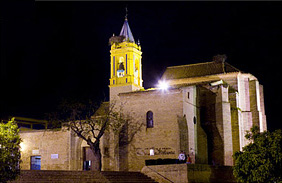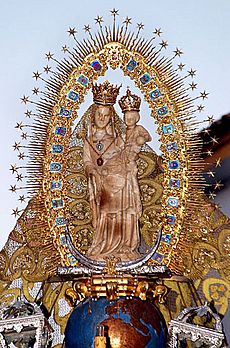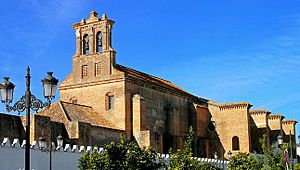Lugares colombinos facts for kids
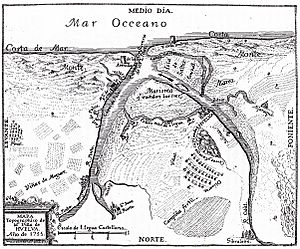
The Lugares colombinos are special places in the province of Huelva in Spain. These spots are very important because they are linked to the first voyage of Christopher Columbus. This was the journey where Europeans first arrived in the Americas. In 1967, these places were officially named a "historic and artistic site."
Two main towns are part of this route: Palos de la Frontera and Moguer. Columbus visited both towns many times. People from these places helped him a lot. The monks at La Rábida Monastery, the Pinzón Brothers from Palos, and the Niño Brothers from Moguer all played key roles. They helped Columbus get ready for his big trip.
After Columbus's voyage, the area, especially Palos, faced tough times. Many people moved away to the new lands across the ocean. But later, a writer named Washington Irving helped bring attention back to these historic places. He visited in 1828 and wrote about them. His writings helped people remember how important this region was to the discovery of America.
Today, the Lugares colombinos remind us of the strong connection between Spain and Latin America. They are some of the most famous historical sites in Huelva.
Contents
Palos de la Frontera: Birthplace of Discovery
Palos: A Historic Port
Palos de la Frontera is known as the "cradle of the Discovery of America." This means it's where Columbus's journey truly began. On April 30, 1492, a royal order was read here. It said that two ships must be provided for Columbus. This happened at the Church of Saint George the Martyr. This church was built in the 1300s and became a National Monument in 1931.
Near the church is a famous old fountain called the Fontanilla. People say Columbus's ships filled up with fresh water here before they left. The fountain is very old, with parts dating back to Roman times. It's covered by a stone structure from the 1200s.
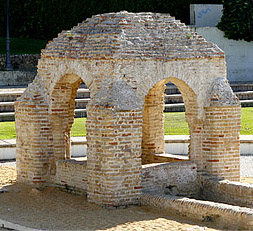
The Pinzón Brothers were from Palos. They were Martín Alonso Pinzón, Vicente Yañez Pinzón, and Francisco Martín Pinzón. They helped Columbus discover America. Martín Alonso was especially important. He was a skilled ship owner and sailor. He encouraged other sailors to join the trip. He also paid for one-third of the journey. He even found better ships for Columbus. Their old house in Palos is now a museum, the Casa Museo de Martín Alonso Pinzón. It still has its original look from the 1400s.
You can also walk along the Rio Tinto river. Near the Calzadilla wharf, a famous flying boat called the Plus Ultra took off in 1926. It made the first flight across the Atlantic Ocean from Spain to South America. Close by is where the old port of Palos used to be. The river has changed over time, so the port is no longer there.
La Rábida: A Place of Support
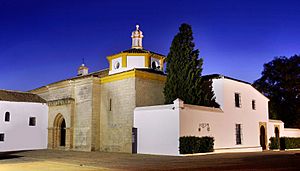
About 3 kilometers (1.8 miles) from Palos is the Franciscan La Rábida Monastery. It was built in the 1300s and 1400s. In 1485, Christopher Columbus came here with his son, Diego. He was tired and sad because he couldn't get help from the King of Portugal.
At this small monastery, Columbus found kindness and support. Two monks, Fray Juan Pérez and Fray Antonio de Marchena, were especially helpful. Fray Juan Pérez had worked for the Spanish court. Fray Antonio de Marchena was a famous astrologer (someone who studied stars). Both monks helped Columbus get support from the royal court. They also helped him find the sailors he needed. The monastery was a safe place for Columbus to develop his ideas.
The monastery's church is beautiful. It has Gothic and Mudéjar styles. There are also large rooms with paintings by Daniel Vázquez Díaz. The museum inside has many items related to the discovery of America. The most special item is the 14th-century statue of the Virgin of Miracles. It's a lovely example of Gothic art. Columbus and his men prayed to this statue the night before they left. In 1993, Pope John Paul II honored the statue. It was the only statue of the Virgin Mary he crowned in Spain.
The monastery was declared a National Monument in 1856. In 1949, it was called the "First historical monument of the Hispanic peoples." It also received the "Gold Medal of Andalusia" in 1992.
Near La Rábida, you can visit the Wharf of the Caravels. This is a museum where you can see copies of Columbus's ships: the Santa María, La Niña, and La Pinta.
Moguer: Home of the Niña
Columbus visited the Santa Clara Monastery in Moguer many times. This convent was built in the 1300s. The abbess, Inés Enríquez, was the aunt of King Ferdinand II. She supported Columbus's plan to sail west.
The monastery has many interesting parts. The Mothers' Cloister has a lower floor from the 1300s. It's the oldest surviving cloister in a Spanish convent. The infirmary is a two-story building from the 1500s. The church has three main sections and a special end part. The main altar has a beautiful carving from 1642. The choir has unique wooden seats from the 1300s. The monastery became a National Monument in 1931. Next to it is the Columbus Monument.
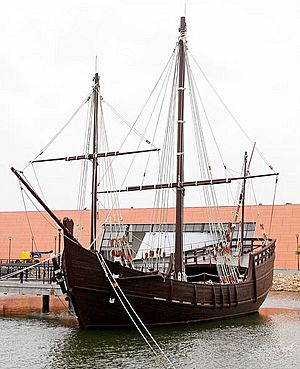
After returning from his first voyage, Columbus and his men spent their first night back in this church. They had made a promise to do so during a big storm at sea. The storm almost sank the Niña, the ship Columbus was sailing.
In Moguer, Columbus also got help from a priest named Martín Sánchez. A landowner, Juan Rodríguez Cabezudo, also helped. Columbus trusted him to look after his son, Diego, during the first voyage.
The King and Queen of Spain told Columbus that towns along the coast must help him get his ships ready. Moguer was one of these towns. Columbus used this order to get two boats here, though they were later replaced.
The caravel Niña was built in Moguer around 1488. It belonged to the Niño Brothers. They also helped find and prepare local sailors for Columbus's journey.
Today, Moguer is also famous as the hometown of the poet Juan Ramón Jiménez (1881–1958). He won the Nobel Prize in Literature in 1956. He is best known for his book Platero y yo. His childhood home is now a museum, the Casa Museo Zenobia y Juan Ramón Jiménez. His birthplace and country house are also museums.
Washington Irving: Sharing the Story
The American writer Washington Irving helped make the Lugares colombinos famous. He visited the area in August 1828. He wrote about it in his diary. He also wrote parts of his book, A History of the Life and Voyages of Christopher Columbus. He even added an essay about Palos to another book.
His writings showed the world how important Palos, La Rábida, Moguer, the Pinzón Brothers, and Fray Juan Pérez were to the discovery of America. In 2001, the local government officially thanked Irving. They recognized his role in saving and sharing the history of these places.
How to Visit the Lugares Colombinos
When the Lugares colombinos first became tourist spots, people traveled by small boats or on an old highway. Today, it's much easier to get there.
- From Huelva city: You can take roads like the H-30, N-442, and H-624. It's about 10 kilometers (6 miles) to La Rábida and Palos de la Frontera. To Moguer, take the H-30, A-49, and A-494. It's about 20 kilometers (12 miles).
- From the province of Seville: Take the A-49 and A-494 to Moguer. It's about 86 kilometers (53 miles). From Moguer, you can easily reach Palos de la Frontera (93 km or 58 miles) and La Rábida (96 km or 60 miles).
See also
 In Spanish: Lugares Colombinos para niños
In Spanish: Lugares Colombinos para niños


